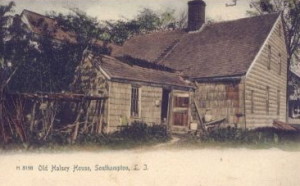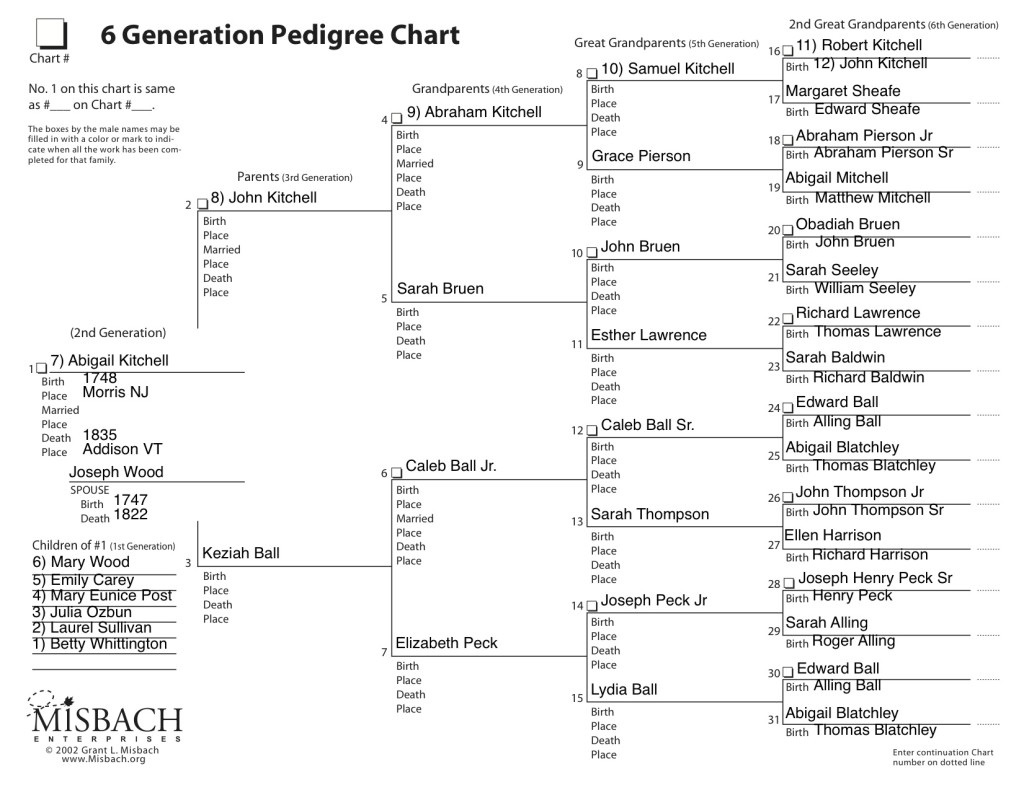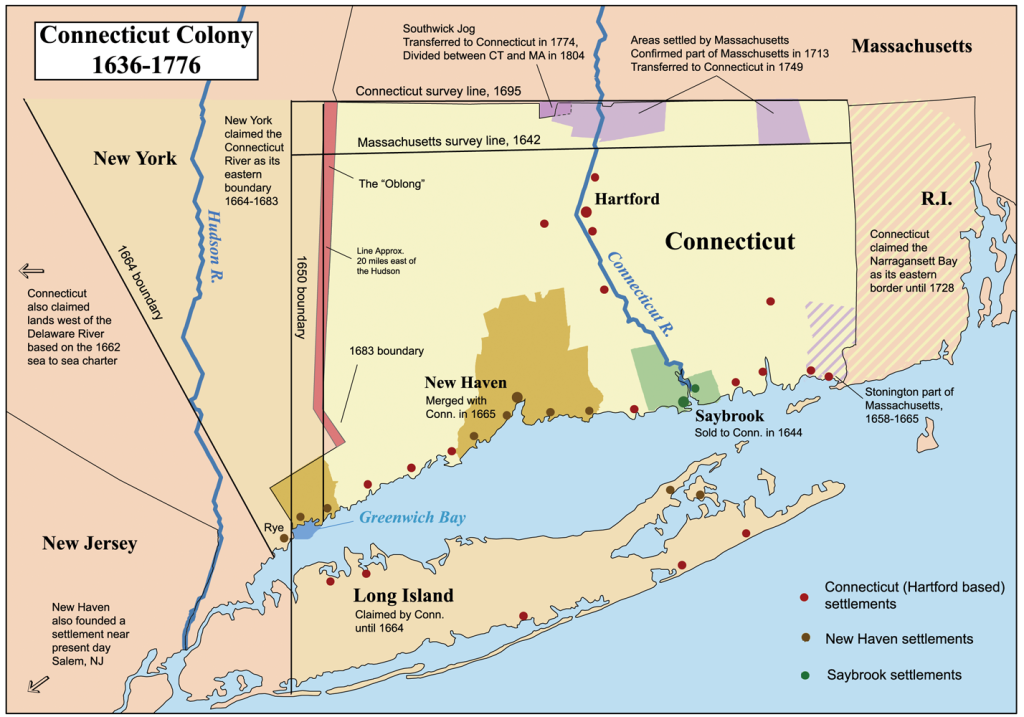Page 2 of the Sullivan line: The New England Roots of our Sullilvan/Osborne Heritage
Generations 1 through 11 (1961-1620)
This Family Tree is remarkable for the number of historical figures found in several generations. The generations are enumerated from the present day Betty through the the years to John Kitchell (12) father of (11) Robert Kitchell. This chart begins with Abigail Kitchell who was found on the previous chart #7. We begin with her because so many of the names on this part of our tree made history together establishing the first communities in present day Maine, Connecticut, Massachusetts, New York and New Jersey. Their history is found within this file, blog, text book, family tree or whatever you want to call this growing body of family history that is gathering around my ‘desktop’. Where’s my coffee mug? It’s in here somewhere! I have to have caffeine if I am going to keep tracking these Protestants back in time.
If you are still trying to track your way back to the monarchs we go from Sarah Bruen at #5 to her grandfather Obadiah Bruehn at #20. This guy left a phenomenal record as an entrepreneur, CFO, communit organizer and workaholic. I put him right up there with my own Wolphert Gerritse von Couwenhoven, the first guy to buy property from the natives at New Amsterdam. Check out Obadiah and the original Wolf of Wall Street.
There are several notable surnames in this branch of our tree whose names are found in countless historical records dating from 1640 through the Revolutionary War and beyond. Perhaps the most noteworthy name would be that of Alling Ball (1617-1689), father of Edward Ball (1642-1724). Alling came to the colonies prior to 1640 and settled into an enclave of like minded church members who were escaping persecution in England and seeking to establish a new order in the New World. Alling was one of six brothers who came, one at a time, to the colonies over the span of a decade. Five of the brothers settled in New England. The sixth, William settled in Virginia. His contribution to American history: George Washington. William’s son Joseph Ball would father Mary Ball, the wife of Augustine Washington, parents of the first President. Thus, my wife and George Washington are each descended from a common great grandfather William Ball, Sr. the father of those six sons who came to the colonies including our direct ancestor Alling and his brother William.
George was not the first revolutionary mind in this family of high minded and politically active citizens. The following families (found in the far column of the attached tree): Kitchell, Sheafe, Pierson, Bruen, Lawrence, Blatchley, Baldwin and Ball were significant players in events in Connecticut and New Jersey. These guys made history a century prior to the arrival of General Washington. In the 1630s our group of Massachusetts Puritans and Congregationalists dissatisfied with Anglican reforms broke with their churches in Boston vicinity and sought to establish a society subject to their own rules and regulations. The Massachusetts General Court granted them permission to settle the cities of Windsor, Wethersfield, and Hartford. The British considered the region to be part of Massachusetts. Ownership of the land was called into dispute by the English holders of the Warwick Patent of 1631. The Dutch also considered the Connecticut River Valley to be the eastern edge of their colony.
New Haven settlements are depicted on the map above. The colony was not chartered. The colonists in Connecticut Colony (Hartford) felt compelled to organize themselves in a government of written laws and established the Fundamental Orders of Connecticut. Unlike the United States Constitution and Declaration of Independence there are no signatures on the Fundamental Orders. Historians speculate that the colonists did not trust the British crown with their lives. Colonists in New Haven followed Hartford’s lead and developed written documents which they boldly signed. A critical difference between the two colonies: New Haven believed church and state were one in the same and the Congregational Church was the official church. Hartford allowed greater religious freedom and created a separation of church and state.
Notice (on the map) that Long Island was claimed by Connecticut, with the exception of the western end, owned and operated by the Dutch and Wulphert van Couwenhoven. There are two mustard colored dots depicting New Haven settlements on the east end of Long Island. One of those is Southampton. The town was founded when ancestors from Lynn, Massachusetts established residence on lands obtained from local Shinnecock Indian Nation in 1640. By 1643 Southampton had a population of 43 families.
 The oldest existent house in the town is the Halsey House at 249 Main Street, which was built by Thomas Halsey, one of the first Englishmen to trade with the Shinnecocks and an ancestor linked into the Bates and Baldwin families in our tree.
The oldest existent house in the town is the Halsey House at 249 Main Street, which was built by Thomas Halsey, one of the first Englishmen to trade with the Shinnecocks and an ancestor linked into the Bates and Baldwin families in our tree.
Abraham Pierson and his congregation would leave Long Island when the settlement broke their connection to New Haven and the Congregational church and followed the rule of Connecticut and the Presbyterian Church. Pierson’s followers relocated to Branford, outside of the community of New Haven. When the Colony of Connecticut was chartered by King Charles II in 1662 the King ordered that it include all New Haven properties. The King’s demand was motivated, in part, by his anger with those who ruled New Haven.
Those who ruled New Haven were harboring three Regiciders from the wrath of Charles II. The Regiciders were 59 men who were responsible for the trial and execution of Charles I in 1649. Charles I had made the mistake of marrying a Catholic and he pushed the agenda of the Church of England. Puritans, led by Oliver Cromwell, threw him out of office and executed him. Cromwell’s death in 1658 reversed the political scene again.
After the Restoration (1660) of the monarchy to Charles II, the new king sought justice and revenge for his father’s death in 1649. William Goffe, John Dixwell , and Edward Whalley were three men who signed the order for execution of Charles I. They fled from England and went to New Haven. The Puritan colonists harbored them from a hit squad sent by King Charles II. The Regiciders were kept in basements and lived in caves on the cliffs above New Haven. Frustrated by the insubordinate colonists, the King was determined to break them.
The requirements of the King’s Charter for Connecticut was the straw that broke our ancestor’s desire to remain in New Haven. They were forced to relocate once again: This time to present day Newark, New Jersey. Pierson, Bruen and others signed their names to an agreement to leave Branford.
Thumbnail sketches of our family members who signed the Branford Agreement.
Sheafe Family: The Reverend Dr. Edward Sheaffe was baptized at Cranbrooke, England in 1559. He married Elizabeth Taylor in 1586. This was before she met Eddie Fisher and Richard Burton. They had at least two children for whom documentation is found: Edmund, m. Elizabeth Cotton, Margaret, m. Robert Kitchell in 1632. Edward died in Cranbrooke, England in 1625. He was closely associated with the Kitchell family and others whose children would migrate to America.
Edward’s first wife, Elizabeth, passed away in 1622 and he then married Joanna Jordan Kitchell. Joanna’s first husband, John, passed away in 1602. This union of Sheafes and Kitchells would be one of many that created a tight bond in the Puritan community both in England and the New World. By his second wife Joanna, Edward fathered three more children: Dorothy, m. Reverend Henry Whitfield, Joanna m. William Chittenden (Guilford Company) and Jacob, m. Margaret Webb (also the Guilford Company). Edward died in 1625. His estate was handled by Robert Kitchell (b. 1601) son of Joanna Jordan Kitchell Sheafe. Robert then married Margaret (Edward Sheafe’s daughter by his first marriage.) By all definitions Robert married his half sister, sister-in-law and best friend’s daughter and all in the same day (and same woman). No wonder they felt obligated to get out of the country.
Edward’s son, Jacob Sheafe, was a member of the Guilford Company and identified as one of the “Seven Pillars of Our Church.” The Guilford Company established the community of Guilford, CT. Present day Guilford contains many of our nation’s oldest existing homes. They were designed to last!
Bruen Family
Obadiah Bruen’s role in the governance of Connecticut and Newark has been briefly reviewed in a previous blog. He descends from a long line of Bruens in England, and the surname is one of the oldest found in the former British empire. His father, John, was 14th in descent from Robert Le Brun of Stapleford (1230). One writer referred to John as “the Greatest Puritan of them all.” Another author says, “though a Puritan, he was no slave to the narrow bigotry of a sect.” That is indeed an uncommon trait not found in a nation (England) torn apart by various religious congregations and the King warring for control of the crown, the church and the country. John’s willingness to accept men of other faiths conflicted with the ecclesiastic mindset of Pierson. References to John Bruen are found in at least eight histories of England.
In a biography (1675) about Queen Elizabeth the author describes John Bruen as a “Gentleman, one of the few individuals whose private virtues alone, in the rank of a country gentleman, have obtained a place in the annals of biography.” John Bruen was shipped off for three years to his Uncle Dutton’s home for an education. He had a private tutor, James Roe, and was involved with his uncle’s minstrel theater group. At age 17, John and brother Thomas were enrolled for a two year stint at St. Albans Hall, Oxford. At age 20 his mom and dad put him in a formal suit and married him off to Mayor Hardware’s daughter, Elizabeth, in Chester.
Elizabeth and John lived the life of leisure on his father’s estate: “He kept 28 dogs for hunting and spent a great deal of time hunting, hawking and such carnal delights. This career of pleasure” came to a crashing end when his dad (John, 1509-1587) passed away. John and Elizabeth were now charged with providing for ten children, paying the debts of the estate and maintaining the property. John took his charge seriously. He ended the park status of his hunting preserve. He sold off the deer, hawks and other wildlife to other estates. His actions reflected his religious convictions that required simplicity, piety and a focus on bare necessities as opposed to the luxuries had had previously enjoyed as a youth.
Elizabeth and John enjoyed 18 years together before her passing. Their marriage produced eight children. Not one to sit idle, he quickly married Anne Foxe and had nine more children. He remained in the Chester area, until such time as he had paid the debts of his father. He was a generous man. His home was a forerunner of the food pantry and soup line. He provided free, hot meals to the poor of the countryside. His home was described as an inn, that operated as a hostel for the traveler, and a bed for the homeless. The estate housed a chapel and John hired a preacher to feed the souls of those he sheltered. The profits from two of the mills he owned covered his costs and provided clothing for the needy.
Bruen was serving local foods before it was cool to do so here in 2014. The meats came from his estate including fish and fowl. His wine cellar was celebrated as one of the finest and while he was generous with a first drink, he policed within the bounds of moderation. One single act best illustrates the man’s need for piety. He “removed all the ancient and beautiful painted windows in his chapel and parish chapel at Tarvin and reglazed them with plain glass at his own expense.” He justified his move by saying “they savored too much of Popery.” Click here to learn more about Obadiah and John’s predecessors: The Holford royalty.
Deacon Richard Lawrence
The Deacon was a prominent member of the New Haven Colony. He was an active leader in the church and was also appointed to many civil offices in which he provided leadership. He joined our ancestors in signing the Fundamental Agreements which bound the Puritan/Congregational Church members to the community move to Newark. He joined Preacher Pierson’s entourage and headed south. He continued as a community leader until his death. His daughter, Esther, was described by authors of the era as
Edward Ball
Ball was one of the first to settle into Branford in the New Haven. He was also one of the first to abandon Branford for Newark. While others were debating whether they should accept the King’s charter and unify with Connecticut, Edward was one of the original 23 two sign the Fundamental Agreement to migrate to Jersey. That date was October 2, 1665. He also signed the second Agreement paperwork in 1666 when the final decision was made to move the wagons out and head south. Ball joined Pierson in a lead role of the effort in 1667. He was a member of the ruling council, a committeeman responsible for boundaries in Newark, and maintained relationships with the Indian tribes in Newark. He was granted 6 acres for his home located between present day Broad and Washington Streets. It is ironic that the street on which he lived would eventually be named after his cousin George Washington, 125 years later.
He Azariah Crane and Joseph Riggs were appointed to work out the details of the purchase of land from the Hockquecanung. He was also charged with the task of documenting the lands that residents had seized for themselves beyond the deeds they had been granted. In 1686 he was appointed city attorney and responsible for insuring city ordinances were in effect and that any offender was prosecuted. In 1693 he was named High Sheriff of Essex.
Quotes and information gleaned from two sources in particular: 1) Burkes American Families with British Ancestry and 2) A History of the Willis Family of New England and New Jersey.




